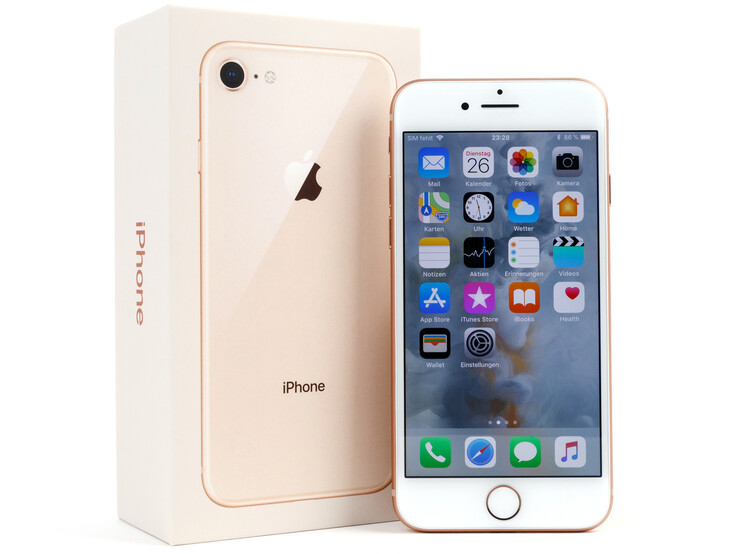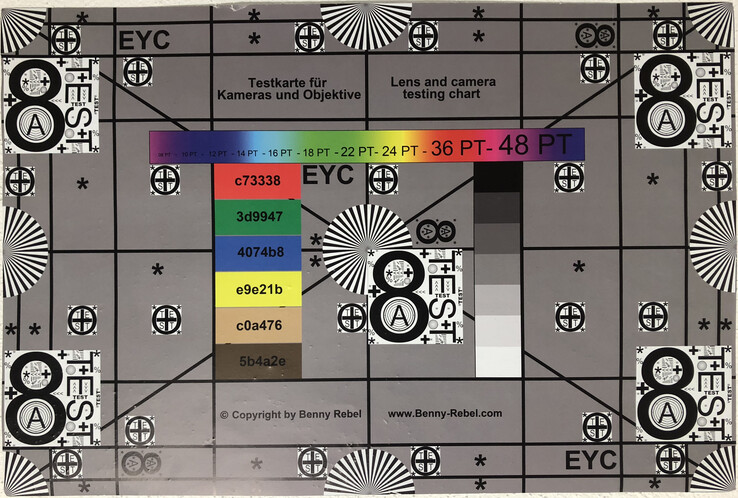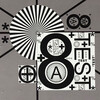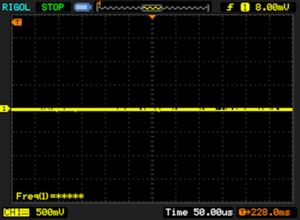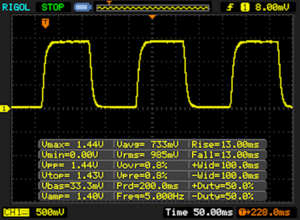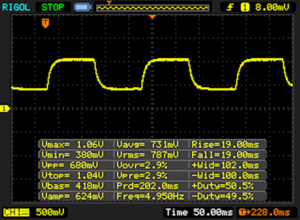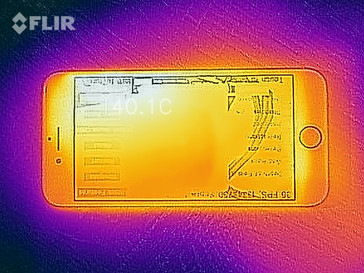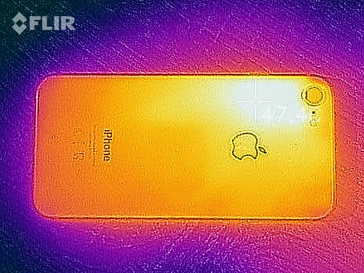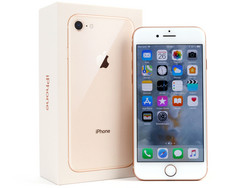Breve Análise do Smartphone Apple iPhone 8
Os Top 10
» Os Top 10 Portáteis Multimídia
» Os Top 10 Portáteis de Jogos
» Os Top 10 Portáteis Leves para Jogos
» Os Top 10 Portáteis Acessíveis de Escritório/Empresariais
» Os Top 10 Portáteis Premium de Escritório/Empresariais
» Os Top 10 dos Portáteis Workstation
» Os Top 10 Subportáteis
» Os Top 10 Ultrabooks
» Os Top 10 Conversíveis
» Os Top 10 Tablets
» Os Top 10 Smartphones
» A melhores Telas de Portáteis Analisadas Pela Notebookcheck
» Top 10 dos portáteis abaixo dos 500 Euros da Notebookcheck
» Top 10 dos Portáteis abaixo dos 300 Euros
| Networking | |
| iperf3 transmit AX12 | |
| Samsung Galaxy S8 | |
| Apple iPhone 8 | |
| Huawei P10 | |
| LG G6 | |
| iperf3 receive AX12 | |
| Apple iPhone 8 | |
| Samsung Galaxy S8 | |
| LG G6 | |
| Huawei P10 | |
| |||||||||||||||||||||||||
iluminação: 91 %
iluminação com acumulador: 604 cd/m²
Contraste: 1373:1 (Preto: 0.44 cd/m²)
ΔE ColorChecker Calman: 1.2 | ∀{0.5-29.43 Ø4.78}
ΔE Greyscale Calman: 1.6 | ∀{0.09-98 Ø5}
99.9% sRGB (Calman 2D)
Gamma: 2.25
CCT: 6688 K
| Apple iPhone 8 A11 Bionic GPU, A11 Bionic, Apple 256 GB (iPhone 8 / Plus) | Apple iPhone 8 Plus A11 Bionic GPU, A11 Bionic, Apple 256 GB (iPhone 8 / Plus) | Apple iPhone 7 A10 Fusion GPU, A10 Fusion, 128 GB NVMe | Samsung Galaxy S8 Plus Mali-G71 MP20, Exynos 8895, 64 GB UFS 2.1 Flash | Huawei Mate 9 Mali-G71 MP8, Kirin 960, 64 GB UFS 2.1 Flash | |
|---|---|---|---|---|---|
| Screen | -4% | -2% | -16% | -88% | |
| Brightness middle (cd/m²) | 604 | 559 -7% | 556 -8% | 560 -7% | 696 15% |
| Brightness (cd/m²) | 580 | 538 -7% | 519 -11% | 562 -3% | 680 17% |
| Brightness Distribution (%) | 91 | 90 -1% | 90 -1% | 93 2% | 93 2% |
| Black Level * (cd/m²) | 0.44 | 0.38 14% | 0.34 23% | 0.42 5% | |
| Contrast (:1) | 1373 | 1471 7% | 1635 19% | 1657 21% | |
| Colorchecker dE 2000 * | 1.2 | 1.3 -8% | 1.3 -8% | 1.7 -42% | 4.3 -258% |
| Colorchecker dE 2000 max. * | 2.3 | 2.7 -17% | 2.6 -13% | 3.4 -48% | 9.4 -309% |
| Greyscale dE 2000 * | 1.6 | 1.8 -13% | 1.9 -19% | 1.6 -0% | 4.8 -200% |
| Gamma | 2.25 98% | 2.25 98% | 2.26 97% | 2.13 103% | 2.33 94% |
| CCT | 6688 97% | 6797 96% | 6818 95% | 6435 101% | 7255 90% |
| Color Space (Percent of AdobeRGB 1998) (%) | 63.15 | 81.57 | |||
| Color Space (Percent of sRGB) (%) | 99.71 | 99.87 |
* ... menor é melhor
Cintilação da tela / PWM (modulação por largura de pulso)
| Tela tremeluzindo / PWM não detectado | |||
[pwm_comparison] Em comparação: 53 % de todos os dispositivos testados não usam PWM para escurecer a tela. Se PWM foi detectado, uma média de 8111 (mínimo: 5 - máximo: 343500) Hz foi medida. | |||
Exibir tempos de resposta
| ↔ Tempo de resposta preto para branco | ||
|---|---|---|
| 26 ms ... ascensão ↗ e queda ↘ combinadas | ↗ 13 ms ascensão | |
| ↘ 13 ms queda | ||
| A tela mostra taxas de resposta relativamente lentas em nossos testes e pode ser muito lenta para os jogadores. Em comparação, todos os dispositivos testados variam de 0.1 (mínimo) a 240 (máximo) ms. » 61 % de todos os dispositivos são melhores. Isso significa que o tempo de resposta medido é pior que a média de todos os dispositivos testados (20.2 ms). | ||
| ↔ Tempo de resposta 50% cinza a 80% cinza | ||
| 38 ms ... ascensão ↗ e queda ↘ combinadas | ↗ 19 ms ascensão | |
| ↘ 19 ms queda | ||
| A tela mostra taxas de resposta lentas em nossos testes e será insatisfatória para os jogadores. Em comparação, todos os dispositivos testados variam de 0.165 (mínimo) a 636 (máximo) ms. » 54 % de todos os dispositivos são melhores. Isso significa que o tempo de resposta medido é pior que a média de todos os dispositivos testados (31.6 ms). | ||
| Geekbench 4.4 | |
| 64 Bit Single-Core Score (classificar por valor) | |
| Apple iPhone 8 | |
| Apple iPhone 8 Plus | |
| Apple iPhone 7 | |
| Huawei Mate 9 | |
| Samsung Galaxy S8 Plus | |
| Samsung Galaxy Note 8 | |
| 64 Bit Multi-Core Score (classificar por valor) | |
| Apple iPhone 8 | |
| Apple iPhone 8 Plus | |
| Apple iPhone 7 | |
| Huawei Mate 9 | |
| Samsung Galaxy S8 Plus | |
| Samsung Galaxy Note 8 | |
| Compute Metal Score 4.1 (classificar por valor) | |
| Apple iPhone 8 | |
| Apple iPhone 8 Plus | |
| Apple iPhone 7 | |
| AnTuTu v6 - Total Score (classificar por valor) | |
| Apple iPhone 8 | |
| Apple iPhone 8 Plus | |
| Apple iPhone 7 | |
| Huawei Mate 9 | |
| Samsung Galaxy S8 Plus | |
| Samsung Galaxy Note 8 | |
| Octane V2 - Total Score (classificar por valor) | |
| Apple iPhone 8 | |
| Apple iPhone 8 Plus | |
| Apple iPhone 7 | |
| Huawei Mate 9 | |
| Samsung Galaxy S8 Plus | |
| Samsung Galaxy Note 8 | |
| Mozilla Kraken 1.1 - Total (classificar por valor) | |
| Apple iPhone 8 | |
| Apple iPhone 8 Plus | |
| Apple iPhone 7 | |
| Huawei Mate 9 | |
| Samsung Galaxy S8 Plus | |
| Samsung Galaxy Note 8 | |
| WebXPRT 2015 - Overall (classificar por valor) | |
| Apple iPhone 8 | |
| Apple iPhone 8 Plus | |
| Apple iPhone 7 | |
| Huawei Mate 9 | |
| Samsung Galaxy S8 Plus | |
| Samsung Galaxy Note 8 | |
* ... menor é melhor
| GFXBench (DX / GLBenchmark) 2.7 | |
| T-Rex Onscreen (classificar por valor) | |
| Apple iPhone 8 | |
| Apple iPhone 8 Plus | |
| Apple iPhone 7 | |
| Huawei Mate 9 | |
| Samsung Galaxy S8 Plus | |
| Samsung Galaxy Note 8 | |
| 1920x1080 T-Rex Offscreen (classificar por valor) | |
| Apple iPhone 8 | |
| Apple iPhone 8 Plus | |
| Apple iPhone 7 | |
| Huawei Mate 9 | |
| Samsung Galaxy S8 Plus | |
| Samsung Galaxy Note 8 | |
| GFXBench 3.0 | |
| on screen Manhattan Onscreen OGL (classificar por valor) | |
| Apple iPhone 8 | |
| Apple iPhone 8 Plus | |
| Apple iPhone 7 | |
| Huawei Mate 9 | |
| Samsung Galaxy S8 Plus | |
| Samsung Galaxy Note 8 | |
| 1920x1080 1080p Manhattan Offscreen (classificar por valor) | |
| Apple iPhone 8 | |
| Apple iPhone 8 Plus | |
| Apple iPhone 7 | |
| Huawei Mate 9 | |
| Samsung Galaxy S8 Plus | |
| Samsung Galaxy Note 8 | |
| GFXBench 3.1 | |
| on screen Manhattan ES 3.1 Onscreen (classificar por valor) | |
| Apple iPhone 8 | |
| Apple iPhone 8 Plus | |
| Apple iPhone 7 | |
| Huawei Mate 9 | |
| Samsung Galaxy S8 Plus | |
| Samsung Galaxy Note 8 | |
| 1920x1080 Manhattan ES 3.1 Offscreen (classificar por valor) | |
| Apple iPhone 8 | |
| Apple iPhone 8 Plus | |
| Apple iPhone 7 | |
| Huawei Mate 9 | |
| Samsung Galaxy S8 Plus | |
| Samsung Galaxy Note 8 | |
| Octane V2 - Total Score (classificar por valor) | |
| Apple iPhone 8 | |
| Apple iPhone 8 Plus | |
| Apple iPhone 7 | |
| Huawei Mate 9 | |
| Samsung Galaxy S8 Plus | |
| Samsung Galaxy Note 8 | |
| JetStream 1.1 - Total Score (classificar por valor) | |
| Apple iPhone 8 | |
| Apple iPhone 8 Plus | |
| Apple iPhone 7 | |
| Huawei Mate 9 | |
| Samsung Galaxy S8 Plus | |
| Samsung Galaxy Note 8 | |
| Mozilla Kraken 1.1 - Total (classificar por valor) | |
| Apple iPhone 8 | |
| Apple iPhone 8 Plus | |
| Apple iPhone 7 | |
| Huawei Mate 9 | |
| Samsung Galaxy S8 Plus | |
| Samsung Galaxy Note 8 | |
| WebXPRT 2015 - Overall (classificar por valor) | |
| Apple iPhone 8 | |
| Apple iPhone 8 Plus | |
| Apple iPhone 7 | |
| Huawei Mate 9 | |
| Samsung Galaxy S8 Plus | |
| Samsung Galaxy Note 8 | |
* ... menor é melhor
(±) A temperatura máxima no lado superior é 41 °C / 106 F, em comparação com a média de 35.2 °C / 95 F , variando de 21.9 a 247 °C para a classe Smartphone.
(±) A parte inferior aquece até um máximo de 43.9 °C / 111 F, em comparação com a média de 34 °C / 93 F
(+) Em uso inativo, a temperatura média para o lado superior é 26.8 °C / 80 F, em comparação com a média do dispositivo de 32.9 °C / ### class_avg_f### F.
Apple iPhone 8 análise de áudio
(±) | o volume do alto-falante é médio, mas bom (###valor### dB)
Graves 100 - 315Hz
(±) | graves reduzidos - em média 14.6% menor que a mediana
(±) | a linearidade dos graves é média (9.2% delta para a frequência anterior)
Médios 400 - 2.000 Hz
(+) | médios equilibrados - apenas 4.3% longe da mediana
(+) | médios são lineares (4.2% delta para frequência anterior)
Altos 2 - 16 kHz
(±) | máximos mais altos - em média 5.1% maior que a mediana
(+) | os máximos são lineares (4.7% delta da frequência anterior)
Geral 100 - 16.000 Hz
(±) | a linearidade do som geral é média (18.2% diferença em relação à mediana)
Comparado com a mesma classe
» 17% de todos os dispositivos testados nesta classe foram melhores, 8% semelhantes, 74% piores
» O melhor teve um delta de 11%, a média foi 35%, o pior foi 134%
Comparado com todos os dispositivos testados
» 38% de todos os dispositivos testados foram melhores, 8% semelhantes, 54% piores
» O melhor teve um delta de 4%, a média foi 24%, o pior foi 134%
Samsung Galaxy S8 análise de áudio
(+) | os alto-falantes podem tocar relativamente alto (###valor### dB)
Graves 100 - 315Hz
(-) | quase nenhum baixo - em média 22.1% menor que a mediana
(±) | a linearidade dos graves é média (11.7% delta para a frequência anterior)
Médios 400 - 2.000 Hz
(±) | médios mais altos - em média 5% maior que a mediana
(+) | médios são lineares (4.3% delta para frequência anterior)
Altos 2 - 16 kHz
(+) | agudos equilibrados - apenas 3.7% longe da mediana
(+) | os máximos são lineares (6.7% delta da frequência anterior)
Geral 100 - 16.000 Hz
(±) | a linearidade do som geral é média (21.8% diferença em relação à mediana)
Comparado com a mesma classe
» 44% de todos os dispositivos testados nesta classe foram melhores, 8% semelhantes, 48% piores
» O melhor teve um delta de 11%, a média foi 35%, o pior foi 134%
Comparado com todos os dispositivos testados
» 61% de todos os dispositivos testados foram melhores, 7% semelhantes, 32% piores
» O melhor teve um delta de 4%, a média foi 24%, o pior foi 134%
Huawei P10 análise de áudio
(+) | os alto-falantes podem tocar relativamente alto (###valor### dB)
Graves 100 - 315Hz
(-) | quase nenhum baixo - em média 20.9% menor que a mediana
(±) | a linearidade dos graves é média (12.6% delta para a frequência anterior)
Médios 400 - 2.000 Hz
(+) | médios equilibrados - apenas 4.2% longe da mediana
(+) | médios são lineares (6% delta para frequência anterior)
Altos 2 - 16 kHz
(±) | máximos mais altos - em média 5.5% maior que a mediana
(+) | os máximos são lineares (4.9% delta da frequência anterior)
Geral 100 - 16.000 Hz
(±) | a linearidade do som geral é média (23.6% diferença em relação à mediana)
Comparado com a mesma classe
» 53% de todos os dispositivos testados nesta classe foram melhores, 8% semelhantes, 39% piores
» O melhor teve um delta de 11%, a média foi 35%, o pior foi 134%
Comparado com todos os dispositivos testados
» 70% de todos os dispositivos testados foram melhores, 6% semelhantes, 24% piores
» O melhor teve um delta de 4%, a média foi 24%, o pior foi 134%
| desligado | |
| Ocioso | |
| Carga |
|
Key:
min: | |
| Apple iPhone 8 A11 Bionic GPU, A11 Bionic, Apple 256 GB (iPhone 8 / Plus) | Apple iPhone 8 Plus A11 Bionic GPU, A11 Bionic, Apple 256 GB (iPhone 8 / Plus) | Apple iPhone 7 A10 Fusion GPU, A10 Fusion, 128 GB NVMe | Samsung Galaxy S8 Mali-G71 MP20, Exynos 8895, 64 GB UFS 2.1 Flash | Huawei P10 Mali-G71 MP8, Kirin 960, 64 GB UFS 2.1 Flash | Sony Xperia XZ Adreno 530, 820 MSM8996, 32 GB eMMC Flash | LG G6 Adreno 530, SD 821, 32 GB UFS 2.0 Flash | |
|---|---|---|---|---|---|---|---|
| Duração da bateria | 12% | -10% | 16% | 7% | -24% | 16% | |
| Reader / Idle (h) | 27.2 | 34.8 28% | 29.5 8% | 27.8 2% | 25.7 -6% | 18.8 -31% | 29.8 10% |
| H.264 (h) | 11.6 | 12.2 5% | 12 3% | 12.9 11% | 9.7 -16% | 8.4 -28% | 13 12% |
| WiFi v1.3 (h) | 9.8 | 11 12% | 8.6 -12% | 12 22% | 16.1 64% | 7.3 -26% | 11.5 17% |
| Load (h) | 3.4 | 3.5 3% | 2.1 -38% | 4.4 29% | 2.9 -15% | 3.1 -9% | 4.2 24% |
Pro
Contra
O iPhone 8 pode ser o último de seu tipo, o último smartphone da Apple com um botão Home e tela IPS. Se este for o caso, os americanos pelo menos nos deram um excelente capítulo final. Mais uma vez, sentimos falta das grandes novidades ou inovações, mas o iPhone 8 ainda supera o seu antecessor em muitos aspectos. Um fator importante é o novo chip A11, que é mais uma vez muito mais rápido e - como muitos modelos anteriores - fora do alcance dos rivais. A carcaça agora é feita de vidro, o que é ótimo para o toque, mas infelizmente é mais escorregadio e propenso a impressões digitais do que antes (exceto o iPhone 7 Jet Black). Parece que o retorno para um painel traseiro de vidro era necessário para o carregamento sem fio.
A câmera é um destaque real para os entusiastas do vídeo em particular, dado que é a primeira câmera de smartphone com gravação de vídeo Ultra HD a 60 quadros por segundo. Os vídeos Full HD podem ser gravados em até 240 FPS, o que é ótimo para espetaculares vídeos em câmera lenta. A qualidade das fotos está em um nível muito bom e não precisa se esconder atrás dos rivais. O iPhone 8 certamente é o melhor pacote de câmera que você pode adquiri hoje em dia em um smartphone – se gostar do menu de configurações essenciais.
O iPhone 8 é poderoso, dura bastante tempo, e possui uma ótima câmera. Não é necessário fazer uma atualização do iPhone 7, mas as diferenças são mais visíveis quando você vem de um iPhone 6S ou um modelo ainda mais antigo.
Você também recebe LTE veloz, longas durações da bateria, e uma carcaça resistente à água e à poeira. Não pudemos encontrar falhas maiores, mas algumas coisas são irritantes. Isto inclui a garantia limitada e o fraco adaptador de força. A qualidade da voz poderia ser melhor nas redes 3G e o som é apenas médio, apesar dos alto-falantes estéreo.
O movimento da Apple em direção à Realidade Aumentada é importante e certamente será bem sucedido graças à grande plataforma e ao enorme potencial de usuários para avanços rápidos e lucrativos na tecnologia. A RA já funciona bem, mas ainda não é tão precisa ou sofisticada em comparação com a do Asus ZenFone AR, por exemplo.
Em suma, o iPhone 8 é um ótimo produto com componentes de gama alta, mas o smartphone e os acessórios úteis também são muito caros.
Apple iPhone 8
- 09/27/2019 v7 (old)
Patrick Afschar Kaboli, Daniel Schmidt




